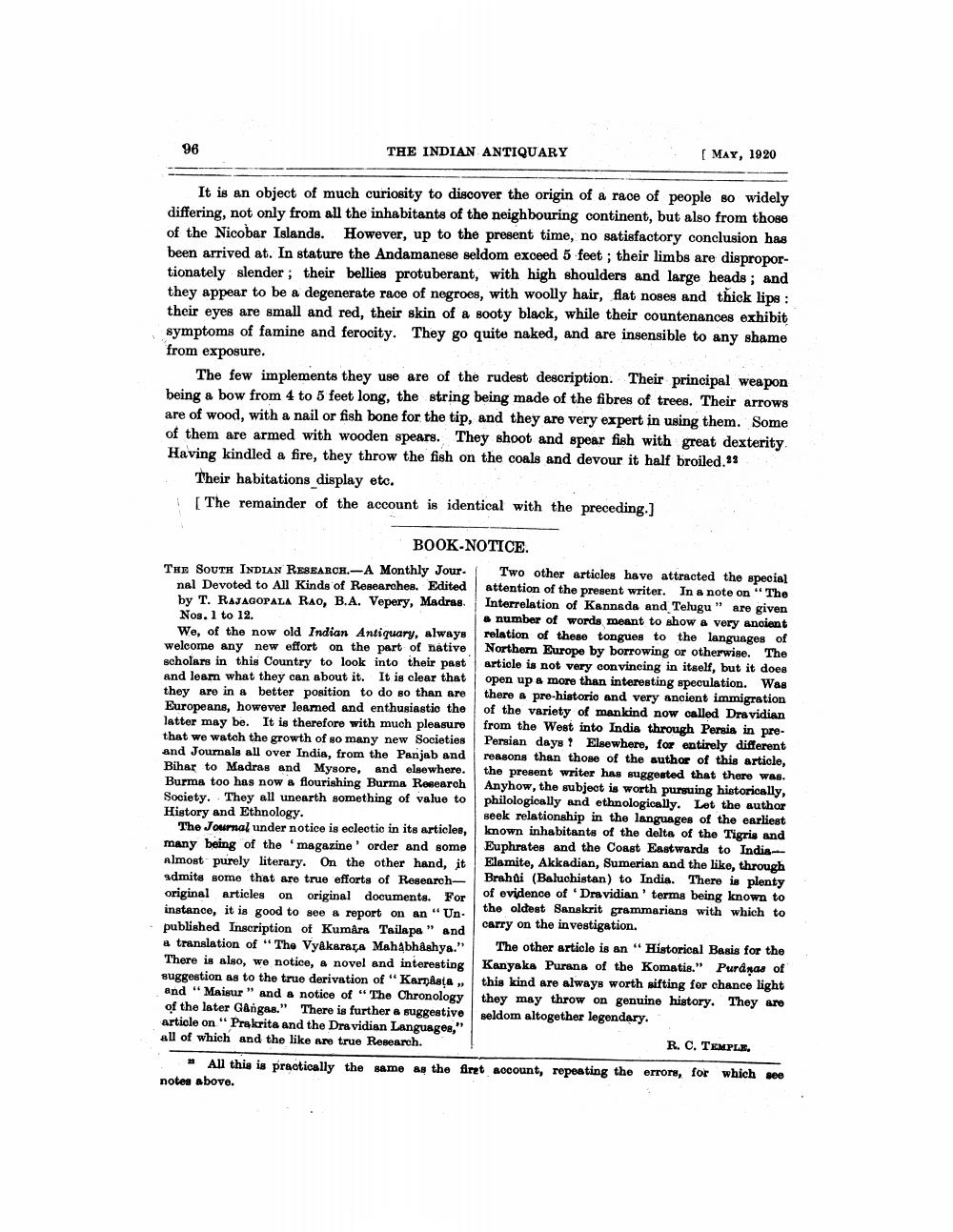________________
96
THE INDIAN ANTIQUARY
MAY, 1920
It is an object of much curiosity to discover the origin of a race of people so widely differing, not only from all the inhabitants of the neighbouring continent, but also from those of the Nicobar Islands. However, up to the present time, no satisfactory conclusion has been arrived at. In stature the Andamanese seldom exceed 5 feet; their limbs are disproportionately slender; their bellies protuberant, with high shoulders and large heads; and they appear to be a degenerate race of negroes, with woolly hair, flat noses and thick lips : their eyes are small and red, their skin of a gooty black, while their countenances exhibit symptoms of famine and ferocity. They go quite naked, and are insensible to any shame from exposure.
The few implements they use are of the rudest description. Their principal weapon being a bow from 4 to 5 feet long, the string being made of the fibres of trees. Their arrows are of wood, with a nail or fish bone for the tip, and they are very expert in using them. Some of them are armed with wooden spears. They shoot and spear fish with great dexterity Having kindled a fire, they throw the fish on the coals and devour it half broiled. 19
Their habitations display etc. [The remainder of the account is identical with the preceding.)
BOOK-NOTICE. THE SOUTH INDIAN RESEARCH.-A Monthly Jour. Two other articles have attracted the special nal Devoted to All kinds of Researches. Edited attention of the present writer. In a note on "The by T. RAJAGOPALA RAO, B.A. Vepery, Madras. Interrelation of Kannada and Telugu" are given Nos. 1 to 12.
• number of words meant to show a very ancient We, of the now old Indian Antiquary, always relation of these tongues to the languages of welcome any new effort on the part of native Northern Europe by borrowing or otherwise. The scholars in this country to look into their past article is not very convincing in itself, but it does and learn what they can about it. It is clear that open up a more than interesting speculation. Was they are in a better position to do so than are there a pre-historio and very ancient immigration Europeans, however leamed and enthusiastio the of the variety of mankind now called Dravidian latter may be. It is therefore with much pleasure from the West into India through Persis in prethat we watch the growth of so many new Societies Persian days? Elsewhere, for entirely different and Journals all over India, from the Panjab and reasons than those of the author of this article, Bihar to Madras and Mysore, and elsewhere. the present writer has suggested that there was. Burma too has now a flourishing Burma Research Anyhow, the subject is worth pursuing historically, Society. They all unearth something of value to philologically and ethnologically. Let the author History and Ethnology.
seek relationship in the languages of the earliest The Journal under notice is eclectic in its articles, known inhabitants of the delte of the Tigris and many being of the magazine order and some Euphrates and the Coast Eastwards to IndiaAlmost purely literary. On the other hand, it Elamite, Akkadian, Sumerian and the like, through admits some that are true efforts of Research
Brahdi (Baluchistan) to India. There is plenty original articles on original documents. For
of evidence of Dravidian' terms being known to
the oldest Sanskrit grammarians with which to instance, it is good to see a report on an "Un. published Inscription of Kumara Tailapа" and
carry on the investigation. a translation of "The Vyakarara Mahabhåshya." The other article is an "Historical Basis for the There is also, we notice, a novel and interesting Kanyaka Purana of the Komatis." Puranas of suggestion as to the true derivation of "Karnata , this kind are always worth sifting for chance light and "Maisur" and a notice of "The Chronology they may throw on genuine history. They are of the later Gangas." There is further a suggestive seldom altogether legendary article on "Prakrits and the Dravidian Languages," all of which and the like are true Research.
R. C. TEMPLE * All this is practically the same as the firgt account, repeating the errors, for which see notes above.




